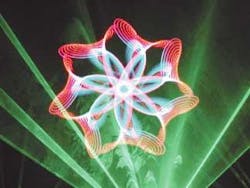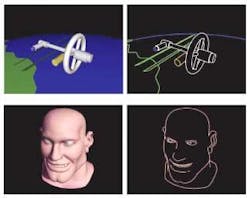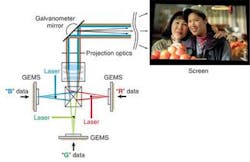Laser light shows take on new dimensions
Advances in solid-state RGB lasers and graphics software have expanded the market for laser-based entertainment, especially in smaller venues.
In today’s highly competitive high-tech world, the inherent beauty of a laser beam is often overshadowed by the all-too-familiar mantra, “smaller, faster, cheaper.” But 40‑years after the laser’s introduction, there remains a contingent of aficionados dedicated to the art behind the technology. In fact, although the laser display/entertainment market generates only about $10 million in sales annually, its supporters are passionate about their craft.
For many years the technology itself kept growth in this segment of the laser industry in check, primarily because the lasers that generated the desired colors and images were large, expensive, and very high-maintenance. But with the advent of more-compact, affordable, and user-friendly solid-state lasers-particularly diode lasers capable of emitting red, green, and blue (RGB) wavelengths-and standardized graphic-design programs, laser light shows are no longer just for planetariums, corporate events, or even nightclubs.
“Control systems and software have evolved to allow us to create better graphics and more evolved imagery, but the new high-power diodes and being able to do more than just green are really opening up this field,” said Paul Torgason, director of business development at LFI International (Bellingham, WA; see Fig. 1). “Diode lasers make it easier to get into markets where lasers weren’t even an option in the past. A lot of the smaller theaters that didn’t have the budgets for lasers before now can afford these new systems.”
Going solid-state
Laser light shows have been around nearly as long as the lasers themselves. In 1968 Lloyd Cross invented “Sonovision,” a patented technique that combined music and lasers; a reflective membrane was stretched over a loudspeaker, and a HeNe laser pointed at the surface produced patterns on a wall or screen in time to music fed to the loudspeaker.1 The first public performance of a laser show took place in 1969 at Mills College (Oakland, CA) using a krypton laser made by Coherent and x-y scanners (galvanometers) made by Honeywell.2 That system incorporated modified galvanometers for beam scanning; the signal sources used to drive the scanners were derived directly from the music, a technique still used today.
For years, the ion laser was the most common type of laser used in light shows. Argon-ion lasers produce light in the green, blue, and violet part of the spectrum, while krypton-ion lasers generate green, yellow, and red light. When a mixture of these two gases is used, the output beam spans the spectrum from violet to red-creating the proverbial white-light laser. But ion lasers offer several challenges; in particular, they are not inherently robust enough for most entertainment applications.
The introduction of the diode-pumped solid-state laser in the late 1990s thus had a profound impact on the laser light-show field. These lasers are inherently smaller, more efficient and reliable, and increasingly more versatile and less expensive than ion lasers. As a result, laser-light displays are finding their way into much smaller venues, from corporate events to shopping-mall advertising (see Fig. 2).
“The real excitement in this industry is the innovations in solid-state lasers,” said William Benner, president and chief technology officer of Pangolin Laser Systems (Orlando, FL), the leading supplier of software for laser light shows. “Ten years ago, the vast majority of this stuff was done with ion lasers. Three years ago, the only solid-state lasers you could find were green, but now RGB solid-state lasers are here and you are seeing the availability of 5-W RGB lasers that can plug into a standard outlet. And as these things continue, it makes it easier (and less expensive) to do shows in venues like theaters and ballrooms, for sales meetings and other events.”
Special effects
But lasers are only one part of a laser light show. Over the last 40 years, laserists have also been preoccupied with finding new and more interesting ways to modify coherent beams and combine them with audio, visual, pyrotechnic, and other special effects to create increasingly dramatic events. The simplest laser light show involves a straight beam through the air, unmoving and/or reflected from a mirror; to make the beam visible, artificial smoke or fog is introduced into the air to create a scattering effect. Water (from fountains, fog, or mist) can also be used to scatter the beam and make it visible, with each water droplet scattering the beam to create a “sparkle” of light at that point.
But for most any laser enthusiast, the icing on the cake is what can be done to a laser beam using various scanning and refractive techniques. These days the graphics involved in a typical laser show include lumia, diffraction patterns, scan patterns, and raster graphics. Lumia effects are created by passing the beam through a slowly rotating transparent object, such as a piece of shower door glass, to create something that looks like the Northern Lights. Diffraction gratings are used to project a wide variety of patterns, from simple circles to complex galaxy-like star images.
“To drive ion lasers and special crystals, our software has to do some magic stuff,” Benner said. “Our software actually has to drive eight different color channels, including red, orange, yellow, and certain shades of green. But the new lasers actually make things easier for our software because our system already controls two and a half times the color channels it needs to.”
On the hardware side, the key to most of these effects is the galvanometer, which enables drawing with light to create abstract and cycloid effects, scanned graphics, and animations. Scan patterns are created by using electronically controlled galvanometer-mounted mirrors to deflect the beam across a surface. Acousto-optic modulators are used to select specific colors and/or vary the beam intensity. When a laser spot is scanned rapidly, the eye perceives a continuous image rather than a moving point of light. The speed of the beam deflection apparatus and the ability to modulate the light precisely offers an artist a great deal of flexibility in producing detailed, visually exciting images. Digital technology complements this capability by allowing the storage and playback of very long and complex sequences.
“Scanners came into play in the early 1970s, but the big advance came in 1992 with the introduction of the model 6800 galvo from Cambridge Technology (Cambridge, MA),” Benner said. “At the same time, another development that made it easier to do multicolor was the PCAOM (polychromatic acousto-optic modulator) crystal, and both arrived at the same time at the same trade show. Now Cambridge (the leading provider of galvo systems for the entertainment market) has come out with yet another scanner (the 6215H) that should make doing full color even easier and less expensive, and the image quality is slightly better.” According to Cambridge, the 6215H has the highest rms (root mean square) acceleration available on the market, resulting in a 60-W, 54-mm tall scanner.
“Our imaging customers have achieved 2-kHz scanning speeds, while our laser projection customers have achieved 60 kpps at 7.5°, much more than what any other galvanometer-based scanner can provide,” said Redmond Aylward, president of Cambridge Technology. “When compared to the industry standard CTI 6210, the 6215H provides more than a 50% increase in maximum rms frequency.”
The PCAOM allows the selection of discrete laser wavelengths with variable intensity-much like a tunable electric prism. The incident laser beam passes through a tellurium dioxide crystal. Specific radio frequencies (RFs) are applied to the crystal, resulting in specific wavelengths being diffracted into the first order. Multiple frequencies will cause multiple spectral lines to be diffracted. The output face of the crystal is cut at a prismatic angle, so all lines are superimposed. The intensity of each line is a function of the RF power at the particular frequency. As long as the RF driver provides the correct frequency corresponding to the wavelength of the laser, almost any wavelength can be used, including 647, 633, 514, 488, 476, and 457 nm. With special tuning the driver can also be modulated to the 568-nm (yellow) and 520-530-nm (green) lines.
Behind the scenes
Finally, every laser light show needs art, and an artist. Increasingly, these two elements are combined in the software that creates the images and controls the ways they are projected. For example, Pangolin’s Lasershow Designer 2000 is the central controlling mechanism and the tool that allows a laserist to create and perform a laser show, in playback or live mode.
“Since 1992 we have been working on one version (of Lasershow) and adding things to it to make it better and easier to use,” Benner said. “Our software is a tool for creating laser shows of any kind, not just graphics but also beam shows and multimedia shows. Whether you are talking about combinations of fireworks and a laser show or video and a laser show, our software can control all of that. Some of our clients even do laser over video, where an image in the video is highlighted in laser light to ‘bring it to life.’ ”
One of the latest additions to the Pangolin system is Lasershow Converter Max (see Fig. 3). In the past, animations were hand-drawn and then scanned into a computer system to then be recreated in a laser formation. Today, most light-show animations are done on a computer using standard PC-based graphics software and then converted into a laser display format that is “show ready” in much less time and with better resolution and color density.
“If you create imagery by drawing with a mouse on the computer or even pencil and paper and scan it into the computer, each image takes about 20 minutes per frame,” Benner said. “On the flip side, you can take a popular graphics package like 3D Studio Max, draw whatever you want, import it into Pangolin, and convert it into a laser show-all at about 10 frames per second. Conversion tools make the process much faster and more powerful, with huge increases in productivity and quality, and anyone can do it.”
REFERENCES
1. A brief history of laser light shows, www.laserfx.com.
2. www.laser.shows.org.
RGB laser projectors attract new audience
In addition to their impact on the laser-light-show field, the development of lower-cost solid-state RGB lasers has opened up new applications in laser-based projection displays. Combining these lasers with new spatial-light modulators has made clear the advantages for laser-projected images having significant color and image quality improvements.
Researchers at Eastman Kodak (Rochester, NY), for example, have developed a grating electromechnical system (GEMS), a diffractive-MEMS spatial-light modulator for use in printing and display applications. The GEMS modulator contains a linear array of pixels capable of high-speed digital operation, high optical contrast, and good efficiency.1 According to its developers, when coupled with RGB laser radiation, the GEMS is capable of producing spectacular still and motion images that create a new visual experience. Images are life-like having a smooth continuous quality with no “screen door” effect, high contrast, extended dynamic range, high resolution, and vivid colors. In addition, computer-generated motion images can provide a unique experience by using the expanded available color gamut to produce highly saturated colors.
“The primary advantage of lasers for display applications is color gamut,” said Greg Niven, director of marketing, graphic arts and display, at Coherent (Santa Clara, CA), which is supplying high-power solid-state lasers to the display industry for applications such as rear-projection TV and digital cinema. “With lightbulbs and microdisplays, you can achieve 40% of the color your eye can perceive. With lasers (RGB primaries), you can get up to 85% of the colors your eye can see. So there is much wider color gamut, extremely high resolution, greater contrast, longer lifetimes, and a much better viewing experience.”
REFERENCE
1. J. Brazas, M. Kowarz, MOEMS Display and Imaging Systems II, eds. H. Urey, D. L. Dickensheets, Proc. SPIE 5348 (2004).




